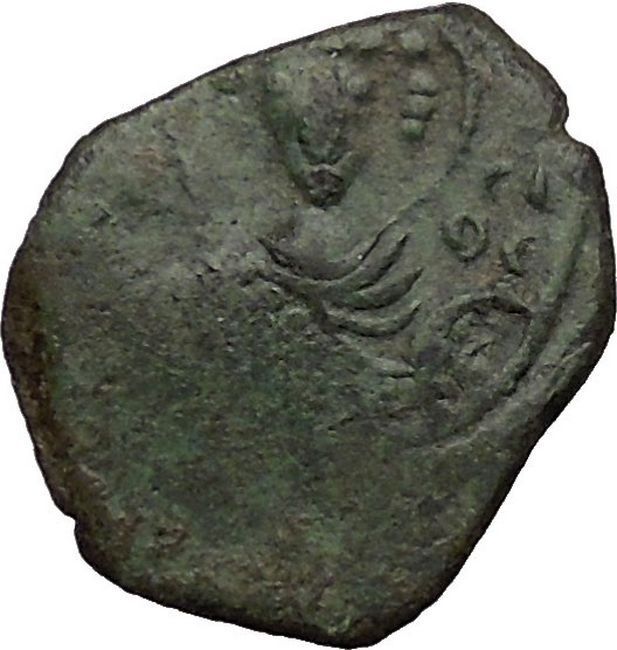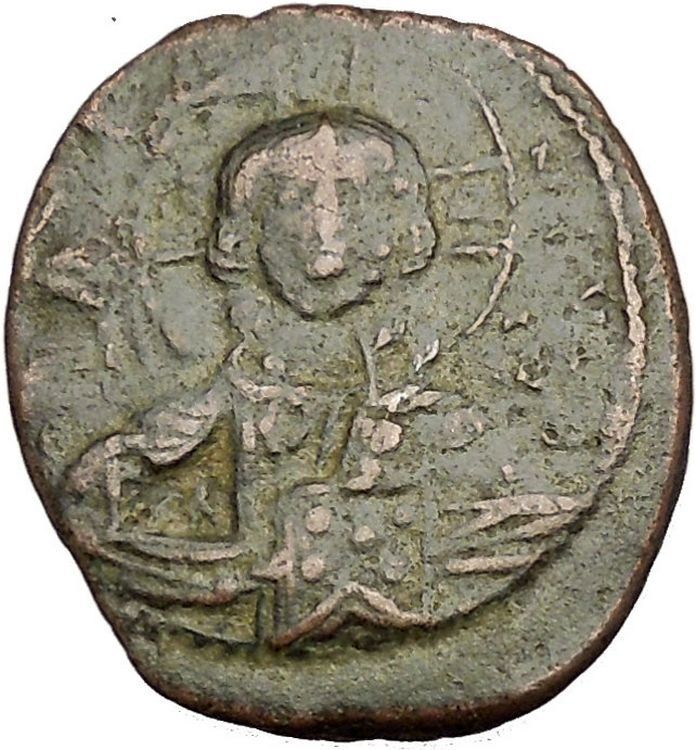|
Byzantine Empire
Anonymous Class H
Bronze Follis 26mm (4.80 grams) Struck circa 1071-1078 A.D.
Struck during the reign of Michael VII – Emperor: October 24,1071 – March 24, 1078 A.D.
Reference: Sear 1880
Bust of Christ facing , wearing a nimbus crown, pallium and colobium, and raising right hand in benediction;
in left hand, book of Gospels; to left, IC; to right, XC; normal border.
Patriarchal cross, with globule and two pellets at each extremity; in lower field, on either side, floral ornament.
For more than a century, the production of Follis denomination Byzantine coins had religious Christian motifs which included included Jesus Christ, and even Virgin Mary. These coins were designed to honor Christ and recognize the subservient role of the Byzantine emperor, with many of the reverse inscriptions translating to “Jesus Christ King of Kings” and “May Jesus Christ Conquer”. The Follis denomination coins were the largest bronze denomination coins issued by the Byzantine empire, and their large size, along with the Christian motif make them a popular coin type for collectors. This series ran from the period of Byzantine emperors John I (969-976 A.D.) to Alexius I (1081-1118 A.D.). The accepted classification was originally devised by Miss Margaret Thompson with her study of these types of coins. World famous numismatic author, David R. Sear adopted this classification system for his book entitled, Byzantine Coins and Their Values. The references about this coin site Mr. Sear’s book by the number that they appear in that work. The class types of coins included Class A1, Class A2, Class B, Class C, Class D, Class E, Class F, Class G, Class H, Class I, Class J, Class K. Read more and see examples of these coins by reading the JESUS CHRIST Anonymous Class A-N Byzantine Follis Coins Reference.
Click here to see all the Jesus Christ Anonymous Follis coins for sale.
Click here to see all coins bearing Jesus Christ or related available for sale.
You are bidding on the exact item pictured, provided with a Certificate of Authenticity and Lifetime Guarantee of Authenticity.
 The Patriarchal cross (☨) is a variant of the Christian cross, the religious symbol of Christianity. Similar to the familiar Latin cross, the patriarchal cross possesses a smaller crossbar placed above the main one so that both crossbars are near the top. Sometimes the patriarchal cross has a short, slanted crosspiece near its foot (Russian Orthodox cross). This slanted, lower crosspiece often appears in Byzantine Greek and Eastern European iconography, as well as in other Eastern Orthodox churches[citation needed]. The Patriarchal cross (☨) is a variant of the Christian cross, the religious symbol of Christianity. Similar to the familiar Latin cross, the patriarchal cross possesses a smaller crossbar placed above the main one so that both crossbars are near the top. Sometimes the patriarchal cross has a short, slanted crosspiece near its foot (Russian Orthodox cross). This slanted, lower crosspiece often appears in Byzantine Greek and Eastern European iconography, as well as in other Eastern Orthodox churches[citation needed].
The Byzantine Christianization came to the Morava Empire in the year 863, provided at the request of Rastislav sent Byzantine Emperor Michael III. The symbol, often referred to as the patriarchal cross, appeared in the Byzantine Empire in large numbers in the 10th century. For a long time, it was thought to have been given to Saint Stephen by the pope as the symbol of the apostolic Kingdom of Hungary.
The two-barred cross has been one of the main elements in the coat of arms of Hungary since 1190. It appeared during the reign of King Béla III, who was raised in the Byzantine court. Béla was the son of Russian princess Eufrosina Mstislavovna. The cross appears floating in the coat of arms and on the coins from this era. In medieval Kingdom of Hungary was extended Byzantine Cyril-Methodian and western Latin church was expanded later.
The two-barred cross in the Hungarian coat of arms comes from the same source of Byzantine (Eastern Roman) Empire in the 12th century. Unlike the ordinary Christian cross, the symbolism and meaning of the double cross is not well understood.
In most renditions of the Cross of Lorraine, the horizontal bars are “graded” with the upper bar being the shorter, though variations with the bars of equal length are also seen.
 Jesus (7-2 BC to AD 30-33), also referred to as Jesus of Nazareth or Jesus Christ, is the central figure of Christianity, whom the teachings of most Christian denominations hold to be the Son of God. Christians believe Jesus is the awaited Messiah (or Christ, the Anointed One) of the Old Testament. Jesus (7-2 BC to AD 30-33), also referred to as Jesus of Nazareth or Jesus Christ, is the central figure of Christianity, whom the teachings of most Christian denominations hold to be the Son of God. Christians believe Jesus is the awaited Messiah (or Christ, the Anointed One) of the Old Testament.
Virtually all modern scholars of antiquity agree that Jesus existed historically, and historians consider the Synoptic Gospels (Matthew, Mark and Luke) to be the best sources for investigating the historical Jesus. Most scholars agree that Jesus was a Galilean, Jewish rabbi who preached his message orally, was baptized by John the Baptist, and was crucified by the order of the Roman Prefect Pontius Pilate. In the current mainstream view, Jesus was an apocalyptic preacher and the founder of a renewal movement within Judaism, although some prominent scholars argue that he was not apocalyptic. After Jesus’ death, his followers believed he was resurrected, and the community they formed eventually became the Christian church. The widely used calendar era, abbreviated as “AD” from the Latin “Anno Domini” (“in the year of our Lord”) or sometimes as “CE”, is based on the birth of Jesus.
 Christians believe that Jesus has a “unique significance” in the world. Christian doctrines include the beliefs that Jesus was conceived by the Holy Spirit, was born of a virgin named Mary, performed miracles, founded the Church, died by crucifixion as a sacrifice to achieve atonement, rose from the dead, and ascended into Heaven, whence he will return. Most Christians believe Jesus enables humans to be reconciled to God, and will judge the dead either before or after their bodily resurrection, an event tied to the Second Coming of Jesus in Christian eschatology; though some believe Jesus’s role as savior has more existential or societal concerns than the afterlife, and a few notable theologians have suggested that Jesus will bring about a universal reconciliation. The great majority of Christians worship Jesus as the incarnation of God the Son, the second of three persons of a Divine Trinity. A few Christian groups reject Trinitarianism, wholly or partly, as non-scriptural. Christians believe that Jesus has a “unique significance” in the world. Christian doctrines include the beliefs that Jesus was conceived by the Holy Spirit, was born of a virgin named Mary, performed miracles, founded the Church, died by crucifixion as a sacrifice to achieve atonement, rose from the dead, and ascended into Heaven, whence he will return. Most Christians believe Jesus enables humans to be reconciled to God, and will judge the dead either before or after their bodily resurrection, an event tied to the Second Coming of Jesus in Christian eschatology; though some believe Jesus’s role as savior has more existential or societal concerns than the afterlife, and a few notable theologians have suggested that Jesus will bring about a universal reconciliation. The great majority of Christians worship Jesus as the incarnation of God the Son, the second of three persons of a Divine Trinity. A few Christian groups reject Trinitarianism, wholly or partly, as non-scriptural.
In Islam, Jesus (commonly transliterated as Isa) is considered one of God’s important prophets and the Messiah, second in importance only to Muhammad. To Muslims, Jesus was a bringer of scripture and was born of a virgin, but was not the Son of God. According to the Quran, Jesus was not crucified but was physically raised into Heaven by God. Judaism rejects the belief that Jesus was the awaited Messiah, arguing that he did not fulfill the Messianic prophecies in the Tanakh.
 Michael VII Doukas or Dukas/Ducas (Greek: Μιχαήλ Ζ΄ Δούκας, Mikhaēl VII Doukas), nicknamed Parapinakēs (Παραπινάκης), was Byzantine emperor from 1071 to 1078. Michael VII Doukas or Dukas/Ducas (Greek: Μιχαήλ Ζ΄ Δούκας, Mikhaēl VII Doukas), nicknamed Parapinakēs (Παραπινάκης), was Byzantine emperor from 1071 to 1078.
Michael VII was born c. 1050 in Constantinople, the eldest son of Constantine X Doukas and Eudokia Makrembolitissa. He was associated with his father on the throne late in 1059, together with or shortly before his newly born brother Konstantios Doukas. When Constantine X died in 1067, Michael VII was 17 years old and should have been able to rule by himself. He exhibited little interest in politics, however, and his mother Eudokia and uncle John Doukas governed the empire as effective regents.
On January 1, 1068, Eudokia married the general Romanos Diogenes, who now became senior co-emperor alongside Michael VII, Konstantios, and another brother, Andronikos. When Romanos IV was defeated and captured by Alp Arslan of the Seljuk Turks at the Battle of Manzikert in August 1071, Michael VII remained in the background, while the initiative was taken by his uncle John Doukas and his tutor Michael Psellos. They conspired to keep Romanos from regaining power after his release from captivity, while Michael felt no obligation to honor the agreement that Romanos struck with the Sultan. After the dispatch of Eudokia to a monastery, Michael VII was crowned again on October 24, 1071 as senior emperor.
Although still advised by Michael Psellos and John Doukas, Michael VII became increasingly reliant on his finance minister Nikephoritzes. The emperor’s chief interests, shaped by Psellos, were in academic pursuits, and he allowed Nikephoritzes to increase both taxation and luxury spending without properly financing the army. As an emperor he was incompetent, surrounded by sycophantic court officials, and blind to the empire collapsing around him. In dire straits, imperial officials resorted to property confiscations and even expropriated some of the wealth of the church. The underpaid army tended to mutiny, and the Byzantines lost Bari, their last possession in Italy, to the Normans of Robert Guiscard in 1071. Simultaneously, they faced a serious revolt in the Balkans, where they faced an attempt for the restoration of the Bulgarian state. Although this revolt was suppressed by the general Nikephoros Bryennios, the Byzantine Empire was unable to recover its losses in Asia Minor.
After Manzikert, the Byzantine government sent a new army to contain the Seljuk Turks under Isaac Komnenos, a brother of the future emperor Alexios I Komnenos, but this army was defeated and its commander captured in 1073. The problem was made worse by the desertion of the Byzantines’ western mercenaries, who became the object of the next military expedition in the area, led by the Caesar John Doukas. This campaign also ended in failure, and its commander was likewise captured by the enemy. The victorious mercenaries now forced John Doukas to stand as pretender to the throne. The government of Michael VII was forced to recognize the conquests of the Seljuks in Asia Minor in 1074, and to seek their support. A new army under Alexios Komnenos, reinforced by Seljuk troops sent by Malik Shah I, finally defeated the mercenaries and captured John Doukas in 1074.
These misfortunes caused widespread dissatisfaction, exacerbated by the devaluation of the currency, which gave the emperor his nickname Parapinakēs, “minus a quarter”. In 1078 two generals, Nikephoros Bryennios and Nikephoros Botaneiates, simultaneously revolted in the Balkans and Anatolia, respectively. Botaneiates gained the support of the Seljuk Turks, and he reached Constantinople first. Michael VII resigned the throne with hardly a struggle on March 31, 1078 and retired into the Monastery of Stoudios. He later became metropolitan of Ephesus and died in Constantinople in c. 1090.
|





 The Patriarchal cross (☨) is a variant of the Christian cross, the religious symbol of Christianity. Similar to the familiar Latin cross, the patriarchal cross possesses a smaller crossbar placed above the main one so that both crossbars are near the top. Sometimes the patriarchal cross has a short, slanted crosspiece near its foot (Russian Orthodox cross). This slanted, lower crosspiece often appears in Byzantine Greek and Eastern European iconography, as well as in other Eastern Orthodox churches[citation needed].
The Patriarchal cross (☨) is a variant of the Christian cross, the religious symbol of Christianity. Similar to the familiar Latin cross, the patriarchal cross possesses a smaller crossbar placed above the main one so that both crossbars are near the top. Sometimes the patriarchal cross has a short, slanted crosspiece near its foot (Russian Orthodox cross). This slanted, lower crosspiece often appears in Byzantine Greek and Eastern European iconography, as well as in other Eastern Orthodox churches[citation needed].  Jesus (7-2 BC to AD 30-33), also referred to as Jesus of Nazareth or Jesus Christ, is the central figure of Christianity, whom the teachings of most Christian denominations hold to be the Son of God. Christians believe Jesus is the awaited Messiah (or Christ, the Anointed One) of the Old Testament.
Jesus (7-2 BC to AD 30-33), also referred to as Jesus of Nazareth or Jesus Christ, is the central figure of Christianity, whom the teachings of most Christian denominations hold to be the Son of God. Christians believe Jesus is the awaited Messiah (or Christ, the Anointed One) of the Old Testament. Christians believe that Jesus has a “unique significance” in the world. Christian doctrines include the beliefs that Jesus was conceived by the Holy Spirit, was born of a virgin named Mary, performed miracles, founded the Church, died by crucifixion as a sacrifice to achieve atonement, rose from the dead, and ascended into Heaven, whence he will return. Most Christians believe Jesus enables humans to be reconciled to God, and will judge the dead either before or after their bodily resurrection, an event tied to the Second Coming of Jesus in Christian eschatology; though some believe Jesus’s role as savior has more existential or societal concerns than the afterlife, and a few notable theologians have suggested that Jesus will bring about a universal reconciliation. The great majority of Christians worship Jesus as the incarnation of God the Son, the second of three persons of a Divine Trinity. A few Christian groups reject Trinitarianism, wholly or partly, as non-scriptural.
Christians believe that Jesus has a “unique significance” in the world. Christian doctrines include the beliefs that Jesus was conceived by the Holy Spirit, was born of a virgin named Mary, performed miracles, founded the Church, died by crucifixion as a sacrifice to achieve atonement, rose from the dead, and ascended into Heaven, whence he will return. Most Christians believe Jesus enables humans to be reconciled to God, and will judge the dead either before or after their bodily resurrection, an event tied to the Second Coming of Jesus in Christian eschatology; though some believe Jesus’s role as savior has more existential or societal concerns than the afterlife, and a few notable theologians have suggested that Jesus will bring about a universal reconciliation. The great majority of Christians worship Jesus as the incarnation of God the Son, the second of three persons of a Divine Trinity. A few Christian groups reject Trinitarianism, wholly or partly, as non-scriptural. Michael VII Doukas or Dukas/Ducas (Greek: Μιχαήλ Ζ΄ Δούκας, Mikhaēl VII Doukas), nicknamed Parapinakēs (Παραπινάκης), was Byzantine emperor from 1071 to 1078.
Michael VII Doukas or Dukas/Ducas (Greek: Μιχαήλ Ζ΄ Δούκας, Mikhaēl VII Doukas), nicknamed Parapinakēs (Παραπινάκης), was Byzantine emperor from 1071 to 1078.




